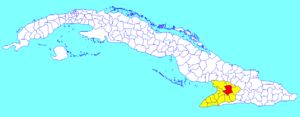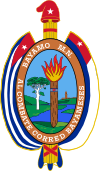Bayamo facts for kids
Quick facts for kids
Bayamo
|
|||
|---|---|---|---|

The "Boulevard" of Bayamo
|
|||
|
|||

Bayamo municipality (red) in
Granma Province (yellow) and Cuba |
|||
| Country | Cuba | ||
| Province | Granma | ||
| Established | November 15, 1513 | ||
| Incorporated | 1827 (city) | ||
| Area | |||
| • Municipality | 918 km2 (354 sq mi) | ||
| Elevation | 55 m (180 ft) | ||
| Population
(2022)
|
|||
| • Municipality | 236,826 | ||
| • Density | 257.98/km2 (668.2/sq mi) | ||
| • Urban | 169,209 | ||
| • Rural | 67,617 | ||
| Time zone | UTC-5 (EST) | ||
| Postal code |
85100
|
||
| Area code(s) | +53 23 | ||
| Vehicle registration | G | ||
| Website | https://www.bayamo.gob.cu/es/ | ||

Bayamo is an important city in Cuba. It is the capital of the Granma Province. You can find it in the eastern part of Cuba, a region known as Oriente. The city is located on a flat area next to the Bayamo River.
Contents
What is Bayamo Like?
Bayamo is a city built on a flat plain. It is near the Bayamo River. Sometimes, a strong wind called the Bayamo wind blows through the area.
One of the most important schools in the province is the University of Granma. It helps many students get a good education.
Bayamo's History
How Bayamo Was Founded
Bayamo was started on November 15, 1513. It was the second city founded by Diego Velázquez de Cuéllar in Cuba. He founded seven cities in total.
A man named Francisco Iznaga became mayor in 1540. He was from a group of people called the Basque. His family later became very important in Cuba's fight for independence.
Bayamo's Early Importance
For a long time in the 1500s, Bayamo was a very important place for farming and trade. It was located inland, which helped protect it from pirates. Pirates often attacked cities along the coast.
Bayamo used the Cauto River to trade goods. Ships could travel down the river to the sea. This allowed Bayamo to trade secretly with other islands like Curaçao and Jamaica. This secret trade made Bayamo a leading town in Cuba by the early 1600s.
Challenges and Changes
In 1616, a huge flood filled the Cauto River with trees and broken ships. This made it harder for ships to reach the sea directly from Bayamo. However, Bayamo continued its secret trade through another port called Manzanillo. This trade continued for many years.
By 1827, Bayamo officially became a city. Later, during the Ten Years' War (1868–1878), Bayamo was a strong base for those fighting for Cuba's freedom. There were many fierce battles near the city. Because of these battles, Bayamo was almost completely destroyed.
People of Bayamo
In 2022, about 236,826 people lived in the municipality of Bayamo. The city itself had about 169,209 people. The total area of Bayamo is about 918 square kilometers (354 square miles). This means there are about 242 people living in each square kilometer.
Getting Around Bayamo
Bayamo is known for its unique ways of getting around. A study by the United Nations found that only about 15% of people use cars or other motorized vehicles to travel.
Instead, many people (about 39%) use horse-drawn carriages. There are about 500 of these carriages, and they follow set routes like buses. Many other people in Bayamo use bicycles or bicycle taxis to get around. This makes Bayamo a leader in sustainable transportation.
The city also has an airport called Carlos Manuel de Céspedes Airport. It offers flights to Havana on Cubana Airlines.
Famous People from Bayamo
Many notable people were born or lived in Bayamo:
- Francisco Vicente Aguilera (1821–1877), a revolutionary leader.
- Carlos Manuel de Céspedes (1819–1874), another important revolutionary.
- Perucho Figueredo (1818–1870), who wrote the Cuban national anthem.
- Pablo Milanés (1943–2022), a famous singer.
- Tomás Estrada Palma (1832–1908), who became the first president of Cuba.
- Ricardo Villaverde (1908–1999), a surgeon and businessman.
- Conrado Roblejo Aguilera (born 1966), a doctor.
- José Antonio Cedeño (born 1939), an artist.
- Felo Ramírez (1923–2017), a radio presenter.
- Rolando Uríos (born 1971), a handball player.
- Alexis Pantoja Perez (born 1969), a painter.
- Sigmund Sobolewski (1923–2017), a Polish Holocaust survivor.
- Sergio Pérez Barrero (Born 1953), a psychiatrist.
See also
 In Spanish: Bayamo para niños
In Spanish: Bayamo para niños



